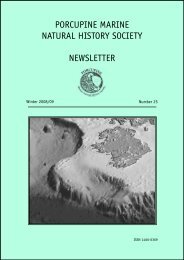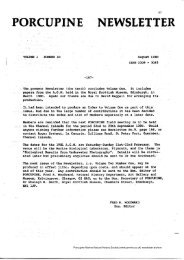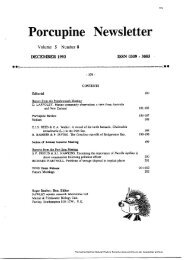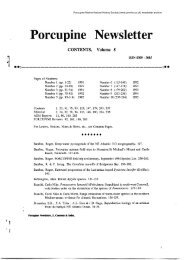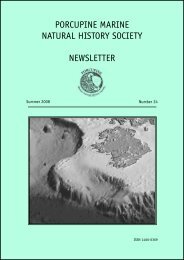Porcupine Newsletter - Porcupine Marine Natural History Society
Porcupine Newsletter - Porcupine Marine Natural History Society
Porcupine Newsletter - Porcupine Marine Natural History Society
You also want an ePaper? Increase the reach of your titles
YUMPU automatically turns print PDFs into web optimized ePapers that Google loves.
The following abstracts were<br />
received from speakers at<br />
<strong>Porcupine</strong> 2005 who have not<br />
submitted a full paper.<br />
Viewing the depths of the<br />
sea<br />
(Subtitle: Collecting underwater<br />
photographs from February 1856 to<br />
February 2005 – an history of failure)<br />
Brian Bett<br />
George Deacon Division for Ocean Processes,<br />
Southampton Oceanography Centre<br />
Perhaps the biggest change in deep-sea<br />
biology since the time of the original <strong>Porcupine</strong><br />
expeditions is our current ability to image the<br />
deep-sea floor. This presentation will examine<br />
the use of photography (and other imaging<br />
techniques) in deep-sea biology: from the early<br />
“Monster Cameras” to the latest imagery from<br />
Autonomous Underwater Vehicles.<br />
The first underwater photograph was<br />
taken in Weymouth Bay in February 1856 by<br />
a noted marine specimen collector, William<br />
Thompson, because he “could not use a pencil”.<br />
Today photography plays a key role in deepsea<br />
investigations, allowing researchers to<br />
access some of the remotest and most hostile<br />
of marine environments. Last month (February<br />
2005) an autonomous underwater vehicle<br />
(AUV) tried, and failed, to photograph the<br />
seafloor deep beneath an Antarctic iceshelf.<br />
This month (March 2005) an AUV is attempting<br />
to locate and photograph new hydrothermal<br />
vents on the Mid-Atlantic Ridge.<br />
‘George Johnston of<br />
Berwick upon Tweed:<br />
‘the father of marine<br />
invertebrate zoology’.’<br />
Peter Davis<br />
International Centre for Cultural and<br />
Heritage Studies, The Bruce Building, University of<br />
Newcastle, Newcastle-uon-Tyne, NE1 7RU<br />
George Johnston is best known for<br />
founding the first ‘<strong>Natural</strong>ists Field Club’ in<br />
Berwick in 1831, which helped to transform<br />
field natural history into a socially acceptable<br />
passtime, and for his catalytic role in the birth<br />
of the Ray <strong>Society</strong>. However, he was also at the<br />
cutting edge of research in marine biology,<br />
writing important books on hydroids, molluscs<br />
and worms. He had an extensive network<br />
of correspondents and friends with whom<br />
he exchanged information and specimens,<br />
and had particularly close relationship with<br />
naturalists based in Newcastle upon Tyne,<br />
including Joshua Alder and Albany Hancock.<br />
This presentation explores Johnston’s life<br />
and work and makes reference to the fate of<br />
Johnston’s collections.<br />
Nematodes and the<br />
environment: taking the<br />
long view with short<br />
worms<br />
Tim Ferrero<br />
Dept. Zoology, The <strong>Natural</strong> <strong>History</strong><br />
Museum, Cromwell Rd., London SW7 5BD<br />
Nematodes are ubiquitous and the most<br />
numerous metazoan fauna of the region of<br />
interest to <strong>Porcupine</strong> members and indeed,<br />
worldwide. They can be studied on a variety<br />
of scales and from the viewpoint of most<br />
biological disciplines: taxonomy, phylogeny,<br />
morphology, ecology, physiology, behaviour<br />
etc. The <strong>Natural</strong> <strong>History</strong> Museum has a long<br />
history of nematode studies and has been<br />
particularly involved with studies aimed<br />
at detecting the impact and recovery from<br />
environmental perturbations. The Thames<br />
Estuary has been subject to chronic pollution<br />
and anthropogenic impact for centuries, but<br />
over the last few decades, has been the subject<br />
of one of the more widely publicized cleanup<br />
operations. In contrast, chronic pollution of<br />
the Arabian Gulf continues to this day and<br />
has been accompanied by large-scale impacts<br />
from petrochemicals associated with war and<br />
political unrest in the region. In situations<br />
such as these, baseline data is often lacking<br />
and impacts and recovery can be difficult<br />
to detect over relevant timescales. This<br />
presentation gave an insight into how we<br />
PMNHS <strong>Newsletter</strong> No.19 Feb 2006 21<br />
<strong>Porcupine</strong> <strong>Marine</strong> <strong>Natural</strong> <strong>History</strong> <strong>Society</strong> (www.pmnhs.co.uk) newsletter archive<br />
21



